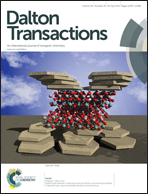Dimer formation upon deprotonation: synthesis and structure of a m-terphenyl substituted (R,S)-dilithium disiloxanolate disilanol†
Abstract
The synthesis and structural characterization of the first dilithium salt of a tetrahydroxydisiloxane, [DmpSi(OH)OLi]2O (6), is described (Dmp = 2,6-dimesitylphenyl). The solid state structure reveals the presence of a dimeric motif where two disiloxane units are linked by coordinating lithium atoms which differs from those found for the sodium and potassium analogs. The arrangement imposed by the cluster formation leads to diastereomeric silicon atoms exhibiting (R,S) configuration in the solid state. In addition, the intermediates of the reaction, monolithiated and dilithiated silanetriol could be identified by means of high-resolution mass spectrometry and the formation of 6 is discussed. Moreover, the fully protonated tetrahydroxydisiloxane, [DmpSi(OH)2]2O has been obtained as well and its solid state structures with varying hydrogen bond acceptors have been surveyed.


 Please wait while we load your content...
Please wait while we load your content...